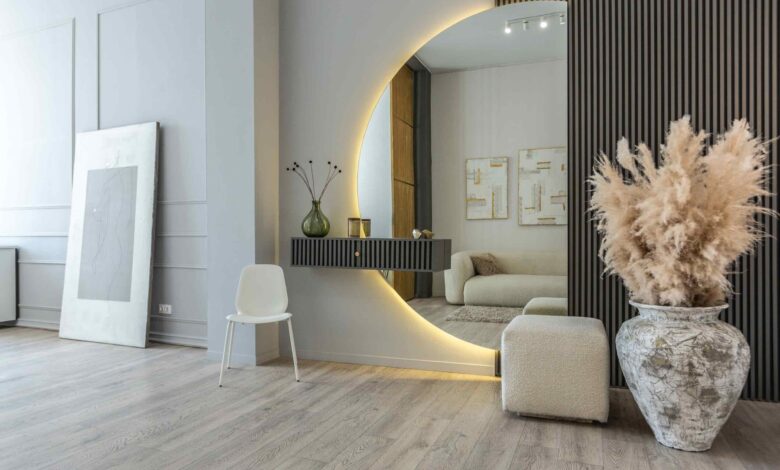The Deeper Meaning Behind Mirrors in Design

Mirrors have always fascinated designers, artists, and homeowners alike. More than decorative pieces, they hold emotional, psychological, and symbolic depth, which bridge beauty, function, and introspection. A mirror doesn’t just reflect what’s in front of it; it reflects how people see themselves within a space. In modern interior design, mirrors are storytellers, connecting light, presence, and emotion in ways few other materials can.
Mirrors as Symbols of Self and Space
At their core, mirrors invite reflection, not just of image, but of identity. They remind you that your surroundings influence how you feel and how you perceive yourself. When placed thoughtfully, mirrors blur the line between person and place, creating an intimate dialogue between the inhabitant and the environment.
A mirror in an entryway, for example, does more than help with last-minute adjustments; it marks a transition point and the boundary between the public and private self. In bedrooms, mirrors evoke a sense of comfort and familiarity, grounding you in your own presence. They offer both literal and symbolic reflection, serving as gentle reminders of balance and perspective in daily life.
Mirrors also play with the concept of duality. They hold up two truths, like what is and what appears to be. In design, this duality becomes powerful, allowing light, shadow, and texture to coexist in harmony, just as reflection and reality merge within a single surface.
See also: How to Choose the Right Industrial Mixer for Your Business
Mirrors as Instruments of Light and Perception
Few design elements can reshape space as effortlessly as mirrors. They manipulate light, depth, and movement to expand the boundaries of a room. A mirror placed opposite a window captures sunlight and diffuses it throughout a space, transforming dim corners into radiant focal points.
This play of reflection can make compact rooms feel open and airy. In larger spaces, mirrors add rhythm and balance by reflecting architectural details, greenery, or soft lighting. Their ability to duplicate sightlines creates a sense of infinite depth and a visual echo that draws the eye deeper into the scene.
Mirrors are not just reflective objects; they are instruments of perception. They invite you to look twice, to see not only what’s there but what could be. In this way, mirrors become tools of imagination, reframing ordinary moments into experiences filled with light, movement, and meaning.
Mirrors as Emotional Anchors
Beyond aesthetics, mirrors shape how a room feels. They engage your emotions, offering comfort, calm, and sometimes even confidence. A well-designed vanity mirror, for instance, serves as both a practical feature and a personal retreat. It’s a space for routine and ritual, where preparation meets self-reflection.
There’s something quietly empowering about facing a mirror in a peaceful setting. It provides a pause before the day begins, or a moment of release before it ends. When framed by natural light or soft illumination, a mirror becomes a symbol of care, grounding you in presence and intention.
Mirrors also contribute to the emotional atmosphere of a home. By capturing glimmers of sunlight, candlelight, or greenery, they infuse interiors with movement and warmth. They mirror not just what’s visible, but what’s felt.
Mirrors as Artistic Statements
Mirrors occupy a unique space between design and art. Their reflective nature gives them a living quality, which is constantly changing as the day progresses, as people move, and as light shifts. Whether framed in ornate gold, sleek metal, or left frameless for a modern touch, mirrors express personality and taste.
A large statement mirror above a fireplace can serve as the heart of a room, while smaller, sculptural mirrors add rhythm and texture to minimalist interiors. They work in harmony with materials like wood, stone, or fabric, creating a balance between shine and softness.
In many ways, mirrors act as silent collaborators in design. They don’t demand attention, yet they enhance everything around them. Their beauty lies in their subtlety and the way they can both disappear and dominate, depending on how they’re placed.
Reflecting More Than Light
Ultimately, mirrors are about more than aesthetics. They symbolize the transformation of light, space, and emotion. They remind you that your home, like yourself, is constantly evolving, capable of reflecting both what is and what could be.
A thoughtfully chosen mirror can turn an ordinary wall into a source of inspiration. It can make a small space feel infinite, or bring stillness into a busy environment. When you design with mirrors, you design with awareness of light, of self, and of the energy that flows through a home.
In every reflection, there’s a story. A mirror doesn’t just show what’s before it; it captures the essence of what’s within.





